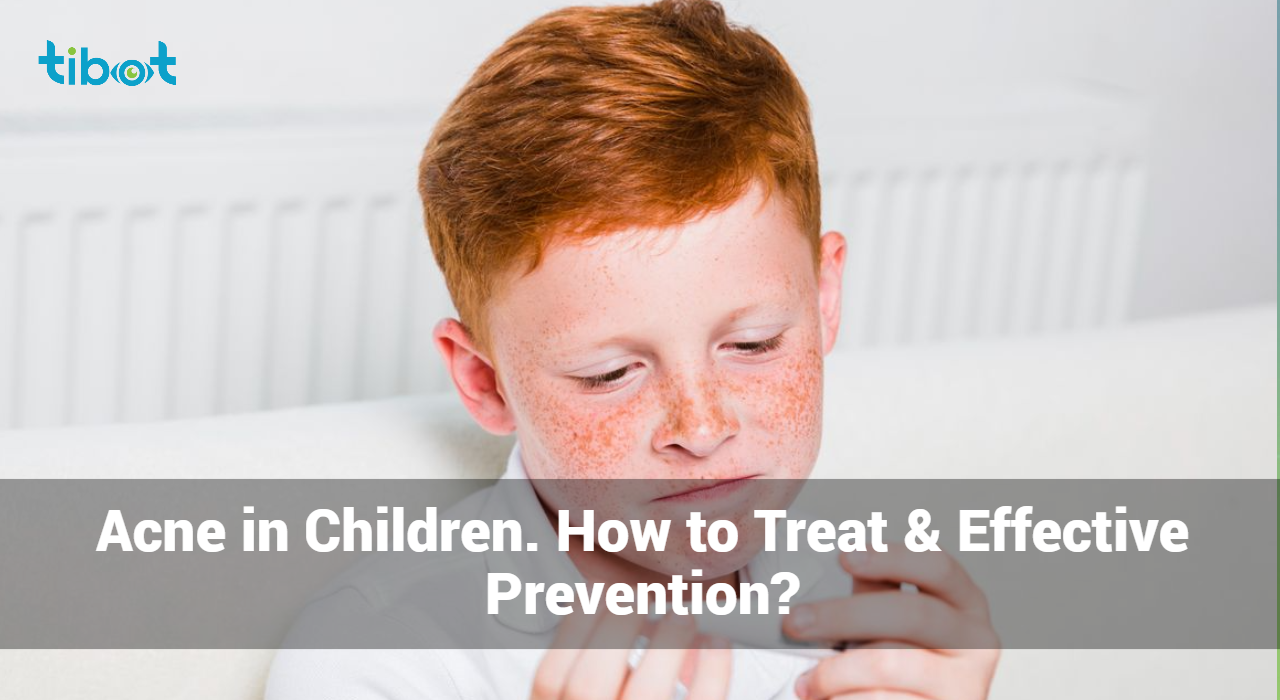Acne in Children. How to Treat & Effective Prevention?

Acne is often associated with adolescence, but it can also affect acne in children, causing distress and discomfort. In this comprehensive guide, we’ll explore the causes, treatment options, and preventive measures for acne in children, providing valuable insights for parents and caregivers.
What is Acne?
Acne is a common skin condition characterized by the formation of pimples, blackheads, whiteheads, and other types of lesions on the skin. It typically occurs when hair follicles become clogged with oil (sebum) and dead skin cells, leading to the development of inflamed or non-inflamed lesions. Acne most commonly affects areas of the skin with a high density of oil glands, such as the face, neck, chest, back, and shoulders.
What is Acne in Children?
Acne in children refers to the development of pimples, blackheads, whiteheads, and other skin blemishes on the face, neck, chest, back, and shoulders. While acne is commonly associated with puberty, it can occur in children as young as 7 or 8 years old and may persist into adolescence and adulthood if left untreated.
What Causes of Acne in Children?
The causes of acne in children is essential for effective management and prevention. Here are several factors that contribute to the development of acne in children:
- Hormonal Changes: Hormonal fluctuations play a significant role in the development of acne in children, just as they do in adolescents and adults. During puberty, the body undergoes hormonal changes that stimulate the sebaceous glands to produce more oil (sebum). Excess sebum production can lead to clogged pores and the formation of acne lesions.
- Genetics: A family history of acne can increase a child’s susceptibility to developing the condition. Genetics can influence factors such as sebum production, skin inflammation, and the likelihood of developing clogged pores, all of which contribute to acne development.
- Bacterial Infections: Propionibacterium acnes (P. acnes) is a type of bacteria that commonly resides on the skin. When pores become clogged with excess oil and dead skin cells, P. acnes bacteria can multiply and cause inflammation, leading to the formation of acne lesions.
- Dietary Factors: While the link between diet and acne is still debated, some studies suggest that certain dietary factors may contribute to acne development in children. Consuming high-glycemic foods (e.g., sugary snacks, processed foods) and dairy products has been associated with an increased risk of developing acne in some individuals.
- External Factors: Environmental factors such as pollution, humidity, and exposure to certain skincare products or cosmetics can exacerbate acne in children. Sweating during physical activity or wearing tight clothing can also contribute to pore blockages and acne breakouts.
- Stress: Stress can trigger hormonal changes in the body, which may exacerbate acne symptoms in children. Additionally, stress-induced behaviors such as touching or picking at the skin can worsen inflammation and lead to further acne lesions.
- Medications: Some medications, such as corticosteroids, lithium, and certain antiepileptic drugs, can trigger or worsen acne in children as a side effect. If a child is taking medication and experiences acne breakouts, it’s essential to consult a healthcare professional for guidance.
- Skin Care Products: Using skincare or hair care products that contain comedogenic ingredients (i.e., substances that can clog pores) can contribute to acne development in children. Parents should choose non-comedogenic products and encourage their children to use gentle skincare routines.
By addressing these underlying factors, parents and caregivers can help prevent and manage acne in children effectively. It’s essential to consult a healthcare professional, such as a pediatrician or dermatologist, for personalized advice and treatment recommendations tailored to the child’s individual needs.
Treating acne in children requires a multifaceted approach aimed at reducing inflammation, unclogging pores, and preventing future breakouts. Here are some common treatment options:
- Topical Treatments:
- Benzoyl Peroxide: Benzoyl peroxide is a topical medication that kills acne-causing bacteria and helps unclog pores. It is available over-the-counter in various strengths and formulations, including gels, creams, and washes.
- Salicylic Acid: Salicylic acid is a beta hydroxy acid (BHA) that exfoliates the skin, removes dead skin cells, and helps unclog pores. It is available in over-the-counter topical treatments, such as cleansers, lotions, and spot treatments.
- Topical Retinoids: Prescription-strength retinoids, such as tretinoin, adapalene, and tazarotene, are derived from vitamin A and help unclog pores, reduce inflammation, and promote cell turnover. They are available in various formulations, including creams, gels, and lotions.
- Oral Medications:
- Antibiotics: Oral antibiotics, such as tetracycline, doxycycline, and minocycline, are sometimes prescribed for moderate to severe cases of acne in children. They work by reducing inflammation and killing acne-causing bacteria. Antibiotics are typically used for a limited duration to minimize the risk of antibiotic resistance.
- Oral Contraceptives: Oral contraceptives containing estrogen and progestin hormones may be prescribed to adolescent girls with acne, particularly if it is associated with hormonal fluctuations. Oral contraceptives can help regulate hormone levels and reduce acne breakouts.
- Isotretinoin: Isotretinoin, also known as Accutane, is a powerful oral medication reserved for severe, treatment-resistant cases of acne in children and adolescents. It works by reducing oil production, preventing clogged pores, and decreasing inflammation. Isotretinoin is associated with potential side effects and requires close monitoring by a dermatologist.
- Professional Procedures:
- Chemical Peels: Chemical peels involve the application of a chemical solution to the skin, which exfoliates the outermost layer and promotes cell turnover. Chemical peels can help improve acne by unclogging pores, reducing inflammation, and fading acne scars.
- Microdermabrasion: Microdermabrasion uses a device to gently exfoliate the skin and remove dead skin cells. It can help unclog pores, improve skin texture, and reduce the appearance of acne lesions.
- Laser Therapy: Laser therapy targets acne-causing bacteria and reduces inflammation by destroying the sebaceous glands’ oil-producing cells. It can be effective for treating inflammatory acne lesions and preventing future breakouts.
- Lifestyle and Skincare Habits:
- Encourage children to wash their face twice daily with a gentle cleanser and to avoid scrubbing or picking at acne lesions, which can worsen inflammation and scarring.
- Teach children to use non-comedogenic (non-pore-clogging) skincare products and cosmetics to prevent pore blockages.
- Encourage a healthy diet rich in fruits, vegetables, whole grains, and lean proteins, and limit sugary and processed foods, which may exacerbate acne.
- Encourage children to avoid touching their face with dirty hands and to keep hair away from the face, especially if it is oily.
- Teach children stress management techniques such as mindfulness, deep breathing, and relaxation exercises to help reduce stress-related acne flare-ups.
It’s important for parents and caregivers to work closely with a healthcare professional, such as a pediatrician or consult a dermatologist, to develop a personalized treatment plan tailored to the child’s individual needs and the severity of their acne. With proper treatment and consistent skincare habits, most cases of acne in children can be effectively managed, improving the child’s skin health and overall well-being.
Analyze Skin Diseases
Use our AI chatbot to determine your skin condition
Prevention Strategies for Acne in Children
Preventing acne in children involves adopting healthy habits and skincare practices to minimize the risk of acne breakouts. Here are some effective prevention strategies:
- Promote Proper Skincare Routine:
- Teach children to wash their face twice daily with a gentle cleanser suitable for their skin type. Avoid harsh scrubbing, as it can irritate the skin and worsen acne.
- Encourage the use of non-comedogenic (non-pore-clogging) skincare products, including moisturizers and sunscreen.
- Instruct children to avoid picking or squeezing acne lesions, as this can lead to inflammation, infection, and scarring.
- Encourage Healthy Diet and Lifestyle Habits:
- Advocate for a balanced diet rich in fruits, vegetables, whole grains, and lean proteins. Limit the consumption of sugary and processed foods, which may exacerbate acne.
- Ensure children stay hydrated by drinking plenty of water throughout the day. Adequate hydration helps maintain healthy skin and may reduce the severity of acne.
- Encourage regular exercise to promote circulation and reduce stress, which can help prevent acne breakouts.
- Stress Management Techniques:
- Teach children stress management techniques such as deep breathing exercises, meditation, yoga, or spending time outdoors in nature.
- Encourage open communication and provide emotional support to help children cope with stressors such as academic pressure, social challenges, or family issues.
- Maintain Cleanliness:
- Encourage children to keep their hair clean and away from the face, especially if it tends to be oily. Greasy hair can contribute to clogged pores and acne breakouts.
- Ensure children change pillowcases and sheets regularly to prevent the accumulation of oil, dirt, and bacteria that can transfer to the skin and exacerbate acne.
- Limit Exposure to Potential Triggers:
- Minimize exposure to environmental pollutants, cigarette smoke, and other irritants that can aggravate the skin and contribute to acne breakouts.
- Encourage children to wear loose-fitting, breathable clothing, especially during hot and humid weather, to prevent sweating and pore blockages.
- Educate About Sun Protection:
- Teach children the importance of sun protection and encourage the regular use of sunscreen with a minimum SPF of 30 when outdoors. Sunscreen helps prevent sunburn and reduces the risk of post-inflammatory hyperpigmentation (dark spots) caused by acne.
- Regular Skin Check-ups:
- Schedule regular check-ups with a pediatrician or dermatologist to monitor the child’s skin health and address any concerns or changes promptly.
- Seek professional advice if acne persists or worsens despite preventive measures, as early intervention can prevent long-term complications and scarring.
By implementing these prevention strategies and promoting healthy habits from an early age, parents and caregivers can help reduce the risk of acne breakouts in children and promote overall skin health and well-being.
When to Seek Medical Advice?
While mild cases of acne in children can often be managed with over-the-counter treatments and lifestyle modifications, it’s essential to consult a dermatologist if:
- Acne is severe, persistent, or causing emotional distress.
- Acne lesions are large, painful, or cystic in nature.
- Acne is accompanied by other symptoms such as fever or joint pain.
Conclusion
Acne in children can be a challenging condition to navigate, but with proper understanding, treatment, and preventive measures, it can be effectively managed. By addressing the underlying causes of acne, implementing appropriate skincare routines, and promoting healthy lifestyle habits, parents and caregivers can help their children achieve clear, healthy skin and improved self-confidence.
In conclusion, acne in children is a common dermatological concern that requires proactive management and support from parents and caregivers. By following the guidelines outlined in this article and seeking timely medical advice when necessary, children can overcome acne and thrive with clear, radiant skin.


Learn about your skin problems for free
Our AI tool is available on the web and on mobile device!




